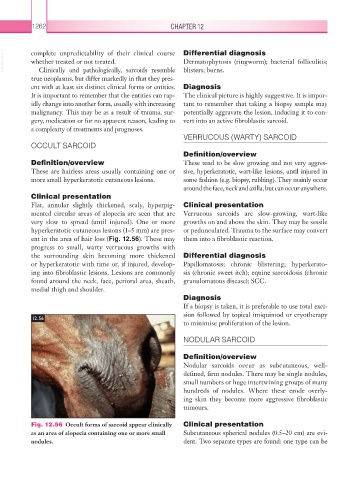Page 1287 - Equine Clinical Medicine, Surgery and Reproduction, 2nd Edition
P. 1287
1262 CHAPTER 12
VetBooks.ir complete unpredictability of their clinical course Differential diagnosis
Dermatophytosis (ringworm); bacterial folliculitis;
whether treated or not treated.
Clinically and pathologically, sarcoids resemble
true neoplasms, but differ markedly in that they pres- blisters; burns.
ent with at least six distinct clinical forms or entities. Diagnosis
It is important to remember that the entities can rap- The clinical picture is highly suggestive. It is impor-
idly change into another form, usually with increasing tant to remember that taking a biopsy sample may
malignancy. This may be as a result of trauma, sur- potentially aggravate the lesion, inducing it to con-
gery, medication or for no apparent reason, leading to vert into an active fibroblastic sarcoid.
a complexity of treatments and prognoses.
VERRUCOUS (WARTY) SARCOID
OCCULT SARCOID
Definition/overview
Definition/overview These tend to be slow growing and not very aggres-
These are hairless areas usually containing one or sive, hyperkeratotic, wart-like lesions, until injured in
more small hyperkeratotic cutaneous lesions. some fashion (e.g. biopsy, rubbing). They mainly occur
around the face, neck and axilla, but can occur anywhere.
Clinical presentation
Flat, annular slightly thickened, scaly, hyperpig- Clinical presentation
mented circular areas of alopecia are seen that are Verrucous sarcoids are slow-growing, wart-like
very slow to spread (until injured). One or more growths on and above the skin. They may be sessile
hyperkeratotic cutaneous lesions (1–5 mm) are pres- or pedunculated. Trauma to the surface may convert
ent in the area of hair loss (Fig. 12.56). These may them into a fibroblastic reaction.
progress to small, warty verrucous growths with
the surrounding skin becoming more thickened Differential diagnosis
or hyperkeratotic with time or, if injured, develop- Papillomatosis; chronic blistering; hyperkerato-
ing into fibroblastic lesions. Lesions are commonly sis (chronic sweet itch); equine sarcoidosis (chronic
found around the neck, face, perioral area, sheath, granulomatous disease); SCC.
medial thigh and shoulder.
Diagnosis
If a biopsy is taken, it is preferable to use total exci-
sion followed by topical imiquimod or cryotherapy
12.56
to minimise proliferation of the lesion.
NODULAR SARCOID
Definition/overview
Nodular sarcoids occur as subcutaneous, well-
defined, firm nodules. There may be single nodules,
small numbers or huge intertwining groups of many
hundreds of nodules. Where these erode overly-
ing skin they become more aggressive fibroblastic
tumours.
Fig. 12.56 Occult forms of sarcoid appear clinically Clinical presentation
as an area of alopecia containing one or more small Subcutaneous spherical nodules (0.5–20 cm) are evi-
nodules. dent. Two separate types are found: one type can be

